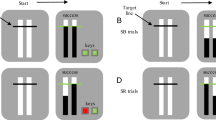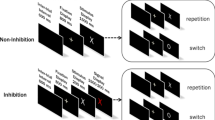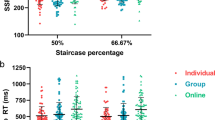Abstract
The stop signal task is widely adopted to assess motor inhibition performance in both clinical and non-clinical populations. Several recent studies explored the influence of strategic approaches to the task. In particular, response slowing seems to be a strategic approach commonly adopted to perform the task. In the present study, we compared a standard version with a strategic version of the task, in which participants were explicitly instructed to slow down responses. Results showed that the instructed slowing did not affect the main inhibition measure, thus confirming the robustness of the stop signal index. On the other hand, it apparently changed the nature of the task, as shown by the lack of correlation between the standard and the strategic versions. In addition, we found a specific influence of individual characteristics on slowing strategies. In the standard version, adherence to task instructions was positively correlated with compliant traits of personality. Despite instructions to maximize response speed, non-compliant participants preferred to adopt a slowing strategy in the standard version of the task, up to a speed level similar to the strategic version, where slowing was required by task instructions. Understanding the role of individual approach to the task seems to be crucial to properly identify how participants cope with task instructions.

Similar content being viewed by others
Notes
For instance, if a participant reached a mean RT of 450 ms in the speed-block, of 600 ms in the standard version and of 750 ms in the strategic version, the resulting percentage of slowing would have been 27% [(600−450)/(1,000−450)] for the standard version, and 55% [(750−450)/(1,000−450)] for the strategic version.
References
Bissett, P. G., & Logan, G. D. (2011). Balancing cognitive demands: Control adjustments in the stop-signal paradigm. Journal of Experimental Psychology: Learning, Memory, and Cognition, 37(2), 392–404.
Chamberlain, S. R., Fineberg, N. A., Blackwell, A. D., Robbins, T. W., & Sahakian, B. J. (2006). Motor inhibition and cognitive flexibility in obsessive–compulsive disorder and trichotillomania. American Journal of Psychiatry, 163, 1282–1284.
Eysenck, H. J., & Eysenck, S. B. (1969). Personality structure and measurement. San Diego: Knapp.
Floden, D., & Stuss, D. T. (2006). Inhibitory control is slowed in patients with right superior medial frontal damage. Journal of Cognitive Neuroscience, 18, 1843–1849.
Lansbergen, M. M., Schutter, D. J. L. G., & Kenemans, J. L. (2007). Subjective impulsivity and baseline EEG in relation to stopping performance. Brain Research, 1148, 161–169.
Leotti, L. A., & Wager, T. D. (2010). Motivational influences on response inhibition measures. Journal of Experimental Psychology: Human Perception and Performance, 36, 430–447.
Liddle, E. B., Scerif, G., Hollis, C. P., Batty, M. J., Groom, M. J., Liotti, M., et al. (2009). Looking before you leap: A theory of motivated control of action. Cognition, 112, 141–158.
Lijffijt, M., Kenemans, J. L., Verbaten, M. N., & van Engeland, H. (2005). A meta-analytic review of stopping performance in attention-deficit/hyperactivity disorder: Deficient inhibitory motor control? Journal of Abnormal Psychology, 114, 216–222.
Logan, G. D. (1994). On the ability to inhibit thought and action: A users’ guide to the stop signal paradigm. In D. Dagenbach & T. H. Carr (Eds.), Inhibitory processes in attention, memory and language (pp. 189–239). San Diego: Academic Press.
Logan, G. D., & Cowan, W. B. (1984). On the ability to inhibit thought and action: A theory of an act of control. Psychological Review, 91, 295–327.
Logan, G. D., Schachar, R. J., & Tannock, R. (1997). Impulsivity and inhibitory control. Psychological Science, 8, 60–64.
Pashler, H. (1994). Dual-task interference in simple tasks: Data and theory. Psychological Bulletin, 116(2), 220–244.
Stewart, J. A. L., & Tannock, R. (1999). Inhibitory control differences following mild head injury. Brain and Cognition, 41, 411–416.
Verbruggen, F., & Logan, G. D. (2009). Proactive adjustments of response strategies in the stop-signal paradigm. Journal of Experimental Psychology: Human Perception and Performance, 35, 835–854.
Yamaguchi, M., Logan, G. D., & Bissett, P. G. (2012). Stopping while going! Response inhibition does not suffer dual-task interference. Journal of Experimental Psychology: Human Perception and Performance, 38(1), 123–134
Acknowledgments
We wish to thank Dr. M. Yamaguchi and an anonymous Reviewer for their useful suggestions.
Author information
Authors and Affiliations
Corresponding author
Rights and permissions
About this article
Cite this article
Sella, F., Bonato, M., Cutini, S. et al. Living on the edge: strategic and instructed slowing in the stop signal task. Psychological Research 77, 204–210 (2013). https://doi.org/10.1007/s00426-012-0419-y
Received:
Accepted:
Published:
Issue Date:
DOI: https://doi.org/10.1007/s00426-012-0419-y




